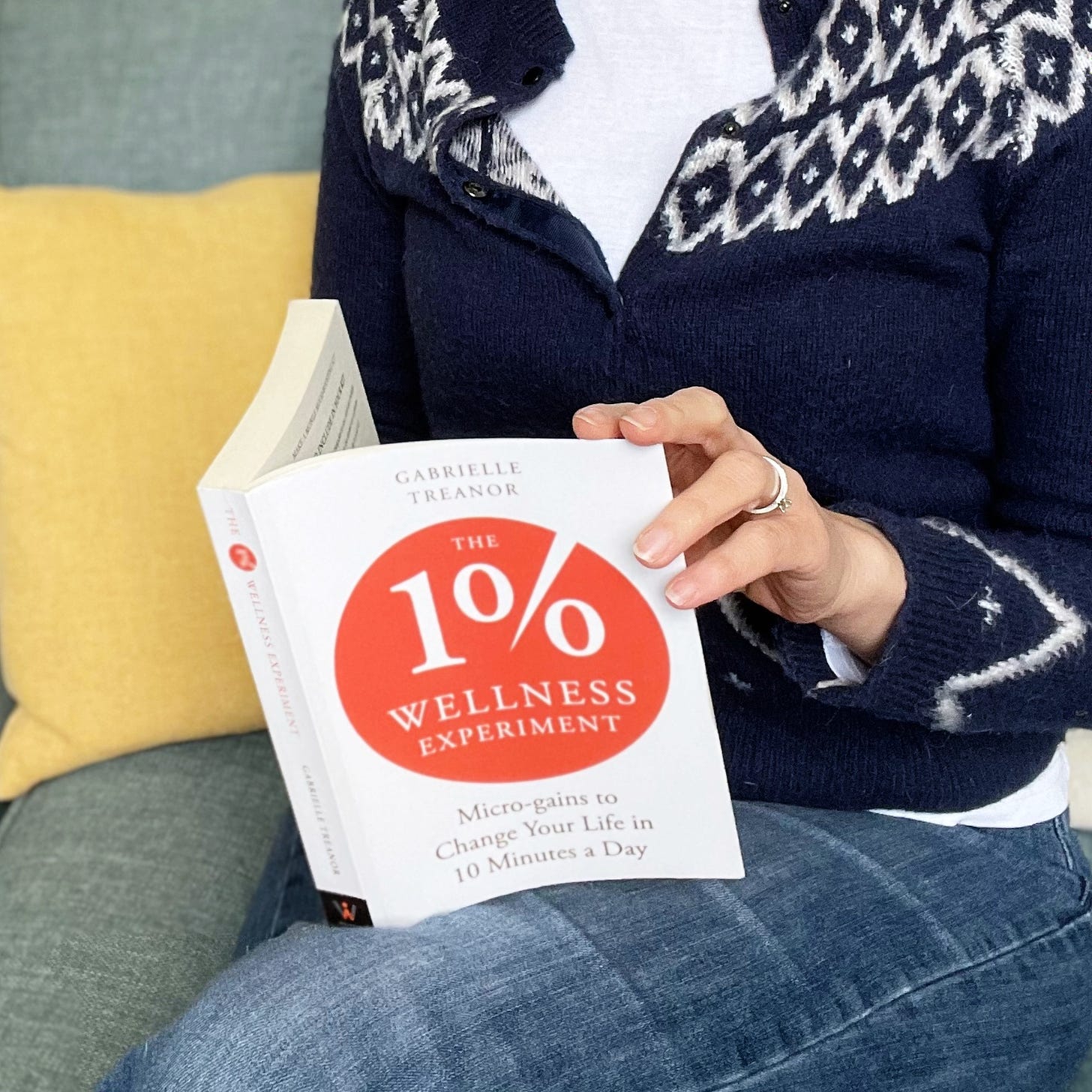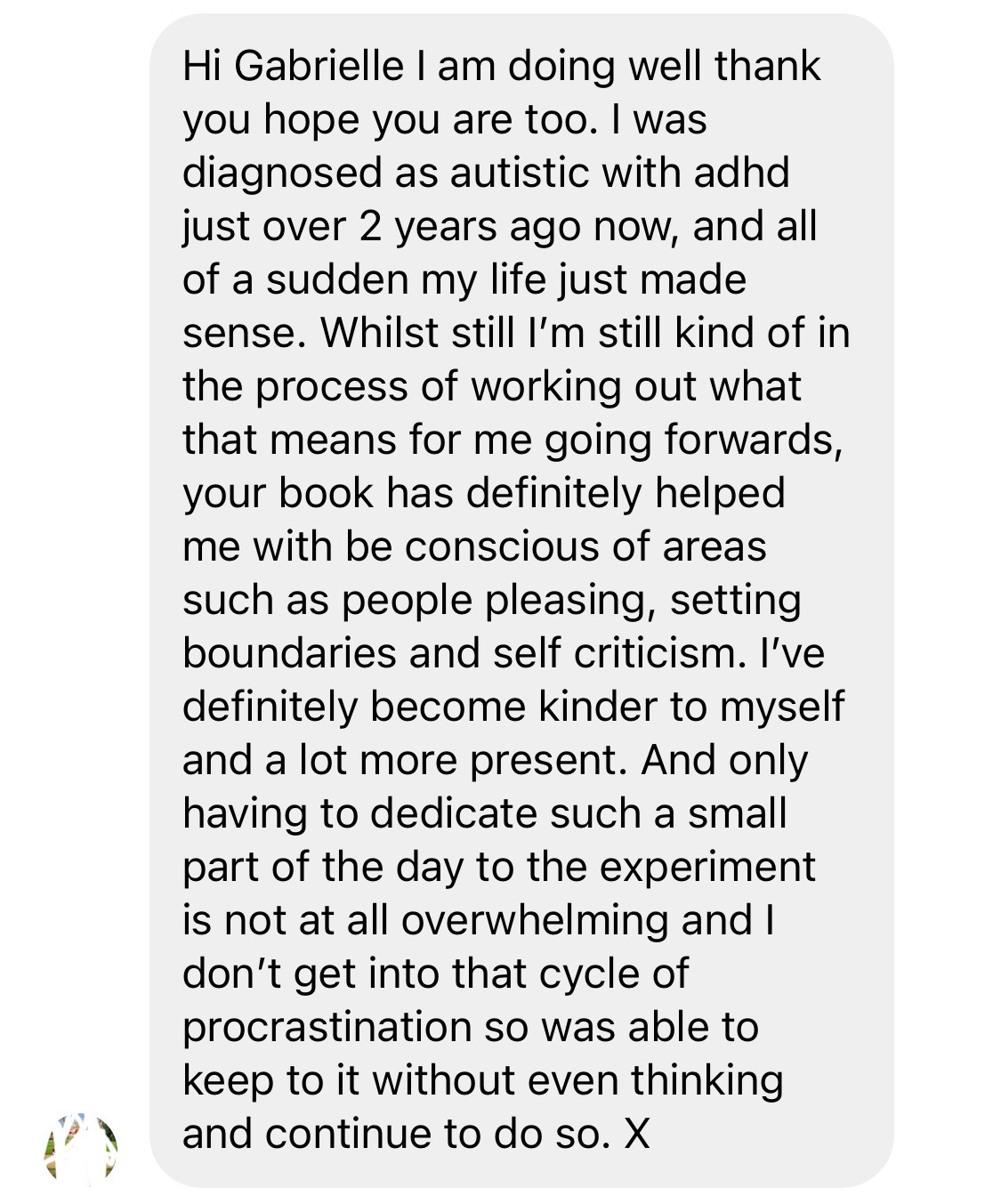Before I begin I’m running a…
Book giveaway!
On 21 June it will be six months since my book, The 1% Wellness Experiment, was published. I’m all for celebrating little and big moments in life so I thought I’d mark this anniversary by giving you the opportunity to win a copy of the book for yourself and one for your friend.
The details to enter are on my Instagram here. Happy six-month book birthday to me and good luck to you!
There’s a technique used to deal with the mean voice in your head – the inner critic – to take the sting out of it. Giving them a name, visualising it as a person and what they’re wearing, or perhaps as an animal or creature, helps to create a space between you and your inner critic.
This separation helps you to hear its harsh, sniping, sneering words as coming from a part of you, (a fearful part – it may sound mean but really it’s scared) not all of you. So when that mean voice says you’re useless, for example, it’s not a factual statement. It’s just the fearful part of you vocalised. You don’t need to take it as truth.
Creating this distance between you and your inner critic is a popular technique because it’s highly effective. It helps you to recognise when that voice is piping up, and that its words are not to be taken as fact. By giving it a name, and perhaps an image, you can speak to that part of you and reassure it.
For example, if it’s saying you’re useless it’s not because you are but because it’s scared if you try to do the thing you’re thinking of you could find it uncomfortable or difficult, make a mistake or get embarrassed. It could also be scared that you might do it well and then you’d have to handle praise or gratitude. You might become more visible or it could lead to more exciting opportunities that it could find scary.
So by naming this fearful part of you and reassuring it that you understand it’s nervous and that’s why it’s resorting to insults to try and stop you, you can let it know that you’re okay. You’re going to do the thing. You know you might not be great at it but you’re going to try anyway so it can pipe down and take a seat. You’re in charge and you’ve got this.
I learned about this strategy for handling my (then) very vocal inner mean girl a long time ago and found it hugely helpful. In case you’re wondering mine is a be-tweeded battleaxe of a woman named Mildred (apologies to all lovely Mildreds out there) with a permanent scowl and hair scraped back so tightly into a bun it’d give you a permanent headache (which doesn’t help her mood).
Think Mrs Trunchbull in Roald Dah’s Matilda.
You can use the same technique to tune into your inner child or inner wise woman so that you can differentiate their messages and recognise they’re parts rather than the whole of you.
One day, post-ADHD discovery, I found myself addressing a part of me as ‘Addy’. The details of the circumstances escape me but it was the all too familiar scenario of thinking of a task I needed to do, getting distracted from it to do something else, getting distracted again by another thing, and then later realising I hadn’t done the first thing and being exasperated with myself for the distraction loop-de-loop.
I caught myself before my inner critic could lambast me. I heard myself saying, “Okay, Addy, you got distracted, it’s okay, it happens, let’s just do it now”. That stopped me in my tracks as I realised I had just named my ADHD brain ‘Addy’ (not very imaginative, I know) and instinctively given it compassion and reassurance, instead of criticism.
This is not my door but it is a lovely, distracting door.
Because I’m not rubbish – and neither are you if you recognise yourself as someone who’s easily distracted because of the myriad thoughts streaming through your brain, whether you have ADHD or not – because I get distracted.
We’re not rubbish or terrible or flaky or bad or any of the other mean things we’ve been told or tell ourselves because we have trouble sticking to a plan or focusing or completing.
It's just that our brains are wired in a way that makes it much easier for us to get distracted than people with brains wired another (neurotypical) way. Especially if it’s not something we’re that interested in in the first place.
By naming my ADHD brain Addy and talking to her with love and kindness I recognise the valid reason why I get distracted and I don’t pile shame and condemnation onto myself for it.
There are other areas of life in which I use this technique to help with something I can find challenging.
For example, after leaving the house I sometimes realise I’ve forgotten my phone or can’t be sure I shut the door properly because I’m thinking about something (or 72 other things) and so didn’t pay attention to making sure I have what I need and done what I need, like shutting the front door properly.
So on the morning I wrote this, as I went out the front door, I said out loud, ‘Addy, I’ve got my phone and everything I need, I’m shutting the front door, we’re all good.” So not only did I remember to take the important items with me I also lodged the door shutting more firmly into my memory by saying it out loud.
You could just say it to yourself without naming your brain but I like the reassurance and compassion directed to my ADHD brain from speaking directly to her.
Essentially this is practising self-compassionate mindfulness – coming out of your thoughts and into the reality of the present moment with no judgement.
It’s practising mindfulness for ten years that has helped me to reduce the overthinking, be more present, feel calmer and so enjoy life more. Along with meditation but we’ll get into that another day.
Would naming your brain (perhaps as well as your inner critic if this is new to you) help to give yourself more compassion and understanding? Do you fancy giving this a try yourself?
I’d love to hear in the comments, or you can message me if you’d prefer.
Until next time,
PS Don’t forget to enter the giveaway on my Instagram here to win copies of The 1% Wellness Experiment for yourself and a friend to celebrate six months since publication!
PPS If what I’m sharing here is resonating you might be interested to know that even though I had no idea of my ADHD at the time I wrote The 1% Wellness Experiment through that lens because it is incredibly neurodivergent-friendly – from the premise through to the experiments themselves. Here’s what one reader messaged me:
Supporting quiet, empathetic, sensitive, introverted late-(self)diagnosed ADHD women find self-acceptance and understanding, as well as calm and joyful freedom to be their unique, beautiful selves.
More for you:
Get your free guides for more calm and joy
Listen to the Pressing Pause podcast
Subscribe to my Substack
Buy my book The 1% Wellness Experiment
How you can work with me:
One-to-one coaching
Take an online course
Supervision for coaches and people who support other people










Love this. My inner critic is called Mergatroid, and we've been doing getting to know each other since 2018. My inner child is called Little Deb (not very imaginative) and my wise voice is called Skye. So many voices, but naming them, and acknowledging them helps so much.
I already have your wonderful book and will be getting one for my friend’s birthday she and her husband have ADHD and I’d already decided they may find it useful before you were diagnosed. I’m also learning about Internal Family Systems which chimes with your inner critic and Addy. The living room of my mind is often full of all sorts of characters! X